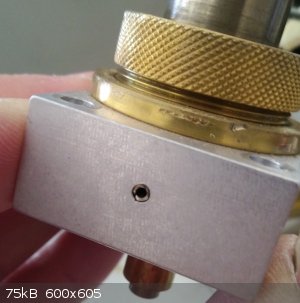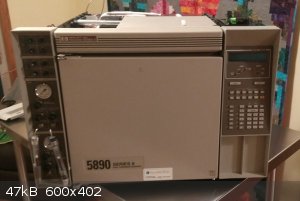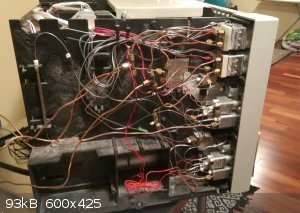Reboot
Hazard to Others
  
Posts: 141
Registered: 8-8-2017
Member Is Offline
Mood: No Mood
|
|
So I bought an (Agilent) HP 5890 gas chromatograph...
Merry Christmas to me! This beautiful old warhorse got dumped on eBay for $600 (with shipping.)
Dual FID (flame ionization detectors), dual split/splitless injection ports. It even came with one of those ancient integrators (a data
logger/printer), which to my astonishment not only works but has ink in it. These beasties have analog voltage outputs if you'd rather use a modern
computer with an A/D converter (like a LabJack) to get your data.
FYI, the entire unit pulls about 1,400 watts while heating the oven, injectors, and detectors. I was a bit worried when I saw the heavy-duty cord
(110v, but with a 20 amp plug) but it turns out that a normal household circuit can handle it.
It looks like I'll spend close to another thousand dollars getting it running (gas tanks, regulators, some second-hand columns, misc fittings like the
ferrules to fit columns, new septa and liner tubes, etc.)
Hopefully I'll have a full write-up once the process is complete, but in the meanwhile I've run into an odd situation: The makeup gas lines to both
FIDs have been removed (either cut or snapped off at the FIDs.)
My understanding is that the makeup gas supply is useful, but not absolutely critical, so I think I'll actually try running the unit without makeup
gas and see what it does.
What happened to the lines is unclear. Both may have eventually snapped off under use (while taking apart the FIDs for cleaning) but perhaps they
were deliberately removed (the supply lines have been neatly trimmed off, as if to say that the owner had no intention of ever reconnecting them.)
The installation of the lines is...curious. The 1/16" stainless tube seems to have been split for a centimeter or so lengthwise, then pressed into a
hole drilled in the block of the FID. Assuming I was able to remove the broken off piece of tube, I have no idea how to recreate this split to fit
a new tube. Rather than fight that one to the death I'll probably just drill it out a little, thread the hole, and install a threaded to swagelock
adapter. Since it's just nitrogen makeup gas I'm not worried about whether the connection is perfect or has a little dead space.
I'm definitely reaching the 'making this up as I go along' stage, but I'm having fun! The machine is very serviceable, designed to be readily fixed
in the field with basic tools. Parts are generally readily available on eBay. The venerable old 5890 is still an impressive piece of hardware, even
if it doesn't have some of the modern bells and whistles. If I can get it working (and I feel very optimistic at this point) it will make a
marvelous addition to the lab. 
  
[Edited on 26-12-2017 by Reboot]
|
|
|
NEMO-Chemistry
International Hazard
    
Posts: 1559
Registered: 29-5-2016
Location: UK
Member Is Offline
Mood: No Mood
|
|
Grab yourself a pc controller (under $150) and download total chrom by elmer perkins, you can then operate and do many things from a pc.
Somewhere on here I got loads of files for servicing and using this GC, i will try and find them for you.
They are the Mutts nuts for sure.
|
|
|
unionised
International Hazard
    
Posts: 5126
Registered: 1-11-2003
Location: UK
Member Is Offline
Mood: No Mood
|
|
That first pic looks like a cotter pin.
What does the rest of that assembly look like?
|
|
|
NEMO-Chemistry
International Hazard
    
Posts: 1559
Registered: 29-5-2016
Location: UK
Member Is Offline
Mood: No Mood
|
|
I missed the bit you mention the lines being cut. This is normally done if the lines leak somewhere on the Hydrogen side, when the machine is serviced
and there is a leak, the machine gets condemned unless the qualified service engineer fix's the leak.
This is one reason some machines pop up cheap (info applies to UK so may not in your case_). Check for any leaks. If the valves or gauges are leaky
this can be expensive to replace. In the UK that pin is also called a split pin, use a punch to remove and replace with a slightly larger one, try not
to drill out.
A good forum for asking GC related stuff
http://www.chromforum.org/
very helpful
[Edited on 26-12-2017 by NEMO-Chemistry]
|
|
|
Reboot
Hazard to Others
  
Posts: 141
Registered: 8-8-2017
Member Is Offline
Mood: No Mood
|
|
Holy carp knuckles, I'm an idiot!
Having looked at it more closely, you are absolutely correct; it's an orientation roll pin. It's just the same size as the gas lines.
I had seen diagrams showing four lines into the FID (the column, hydrogen fuel, air for oxidizer, and nitrogen for makeup) but there are only three
physical lines to these FIDs (column and two others.) I assumed that meant one line was missing, and there are two lines from the flow controllers
that are simply bare tubing, cut off about a foot away from the controllers.
Looking at it now, I think the answer must be that the auxiliary (makeup) gas is being mixed into either the hydrogen fuel line or the air line at the
control valves, which would explain why there's only two. Now, I suspect that the cut off lines are actually vents to carry internally leaked gas
away from the control valves and release it near the back of the unit.
Wow, you have saved me a lot of wasted effort. :-) Thank you!
|
|
|
aga
Forum Drunkard
    
Posts: 7030
Registered: 25-3-2014
Member Is Offline
|
|
Reboot must be of the American persuasion - Cotter pins are called Split-pins over there.
If you get the thing working, PLEASE do a write-up on how to get it going, what the working conditions are and how to make sense out of the damned
things.
Some spectra from things like ethanol, acetone, fart gas etc would be good - anything that would easily be available to any amateur.
|
|
|
NEMO-Chemistry
International Hazard
    
Posts: 1559
Registered: 29-5-2016
Location: UK
Member Is Offline
Mood: No Mood
|
|
You should have a carrier gas line, air line, and Hydrogen for the FID. Often you get an extra Hydrogen line etc as you can get two detectors running
side by side. If you only have one detector then its 3 lines?
For air its best to use an oil less dentist compressor. I cant remember the exact name, but on the normal sources is a book on Gas chromatography, the
machine used in the book is the same as yours.
|
|
|
Texium
Administrator
       
Posts: 4583
Registered: 11-1-2014
Location: Salt Lake City
Member Is Offline
Mood: PhD candidate!
|
|
Quote: Originally posted by aga  | | Reboot must be of the American persuasion - Cotter pins are called Split-pins over there. |
Eh, I don't know
about that, I've always heard cotter pins.
|
|
|
NEMO-Chemistry
International Hazard
    
Posts: 1559
Registered: 29-5-2016
Location: UK
Member Is Offline
Mood: No Mood
|
|
I think the terms are now swapped over. The pins some like me in the UK call cotter pins, they are the ones with a kind of eye at the top and are
split down the middle. These are actually called split pins...
Cotter pins are the ones in the pic here on the thread, although i know them as split pins!! or actually i know them as rolled pins. But as i said I
am actually wrong on this. Then again even google cant agree on it
|
|
|
Dr.Bob
International Hazard
    
Posts: 2736
Registered: 26-1-2011
Location: USA - NC
Member Is Offline
Mood: No Mood
|
|
That is a great GC, used them years ago, and we still use them where I work now.
They are about as easy to adjust as an old carburetor, but with a little work they are great. You can get purity levels for many solvents and
compounds easily at the 0.1% or less of each component, likely better.
|
|
|
unionised
International Hazard
    
Posts: 5126
Registered: 1-11-2003
Location: UK
Member Is Offline
Mood: No Mood
|
|
Quote: Originally posted by aga  | Reboot must be of the American persuasion - Cotter pins are called Split-pins over there.
|
Don't they know the difference between cotter pins and split pins?
Anyway, while it has been a long time, I used GCs like that in the past.
It's an interesting project.
Now all you need is a mass spec to bolt onto the end. :-)
|
|
|
Reboot
Hazard to Others
  
Posts: 141
Registered: 8-8-2017
Member Is Offline
Mood: No Mood
|
|
Quote: Originally posted by NEMO-Chemistry  | Grab yourself a pc controller (under $150) and download total chrom by elmer perkins, you can then operate and do many things from a pc.
|
I don't have a computer that can take expansion cards; do you know if there are any USB options?
| Quote: | | Now all you need is a mass spec to bolt onto the end. :-) |
Oh, my, that would be lovely. For the moment I'm just grateful that my amazing wife didn't think I was insane for wanting a gas chromatograph (and a
tank of 'boom helium' to power it) in the house. We actually had a fun discussion on lower explosive limits and what the chances were of an
explosion if the hydrogen tank leaked.
Gas supplies have been the main additional expense so far. Around $200 per tank ('lifetime lease' and first fill), plus regulators (averaging around
$120 each), plus filters to remove organics (and trace oxygen/moisture for the hydrogen supply), which I've found at surplus for around $35 each.
It's been an interesting process to learn about what these units need.
In terms of consumables/supplies, after the gas there's:
Rubber septums that you stick the sample syringes through. They cost about a dollar each, and they recommend replacing them on as much as a daily
basis for machines that run 24 hours a day.
Below the rubber septum, there's a small glass tube with an o-ring. The sample gets vaporized inside this tube. As gunk builds up over time they
need replacement.
Immediately after the injection port you have the capillary column, which can be fouled by samples with relatively non-volatile compounds and can be
corroded by oxygen or water in the carrier gas. I'm planning on using hydrogen. Helium is also widely used. The lower mass gasses give sharper
separation of samples. If the carrier gas is carefully filtered to remove oxygen and moisture the columns should have very long life spans. I found
a couple used/surplus columns for about $30 each; one looks like it's never been used, with the factory end caps still on it. Installing a column
requires finding the right size of ferrules (basically the metal gaskets between the capillary and the plumbing of the GC.)
It adds up to a laundry list of small parts that need to be identified and collected, but none of them were notably expensive. Agilent has been
conservative with their designs; the consumables are largely the same for all models so availability hasn't been a problem.
The FIDs (flame ionization detectors) are monuments to simplicity. It's basically just a little hydrogen powered gas lamp with a wire going to the
FID controller board. The electrode picks up stray electricity being produced by burning carbon and Bob's your uncle. Other than throwing a few
parts in a sonic cleaner to remove soot now and then, it looks like an almost immortal device.
Even though it's ancient by most standards, even though they're being essentially dumped on the market as obsolete scrap, I've been really impressed
by the quality and elegance of this old machine. It's essentially everything a new unit (costing as much as a new car) is, minus a fancier computer
and some bells and whistles (like computer adjustable gas pressure instead of turning a knob on a regulator.) It's a sexy, sexy beast and I'm
delighted to have it. :-)
|
|
|
XeonTheMGPony
International Hazard
    
Posts: 1640
Registered: 5-1-2016
Member Is Offline
Mood: No Mood
|
|
cotter is a looped wire, one side rounded other flat, the flats are pressed together to make the round pin with the bend point made into a loop.
Roll pin/split pin, is a piece of tubular steel that's been cut along its axis, usually a spring steel, or special purpose metals for the job
Gas scrubbing a field close to my heart! especially on the H2 side!
Mind you I was going to use mine to run a fuel cell, never did get that far!
But a very good cheap home made o2 scavenger is hand warming packs! it is finely ground iron, some carbon and sodium chloride.
So making a stack of that, then final stack being cobalt chloride doped silica gell you can get some very very dry O2 free H2 gas/
I made my own H2 via hoffman bridge, hence the need for aggressive scrubbing. I left out the Alkali scrubbers as they won't be needed for your needs
[Edited on 29-12-2017 by XeonTheMGPony]
|
|
|
unionised
International Hazard
    
Posts: 5126
Registered: 1-11-2003
Location: UK
Member Is Offline
Mood: No Mood
|
|
Quote: Originally posted by XeonTheMGPony  |
cotter is a looped wire, one side rounded other flat, the flats are pressed together to make the round pin with the bend point made into a loop.
|
That's a split pin- you can tell- it splits into two when used.
|
|
|
XeonTheMGPony
International Hazard
    
Posts: 1640
Registered: 5-1-2016
Member Is Offline
Mood: No Mood
|
|
https://en.wikipedia.org/wiki/Cotter_pin
Seems cotter fields a verity or rather covers a group of them, non the matter as his is a roll pin in the end, Oddly here I've heard more then once
techs call the roll pin a split pin and assumed it was a common slang for them, mind you out here seems people aren't worried about technical accuracy
<_<
Here we just call them cotters if it splits or not, less it is a roll pin, to which oddity is above mentioned
|
|
|